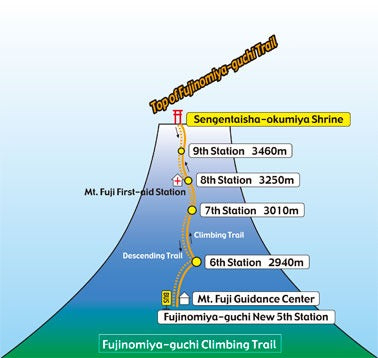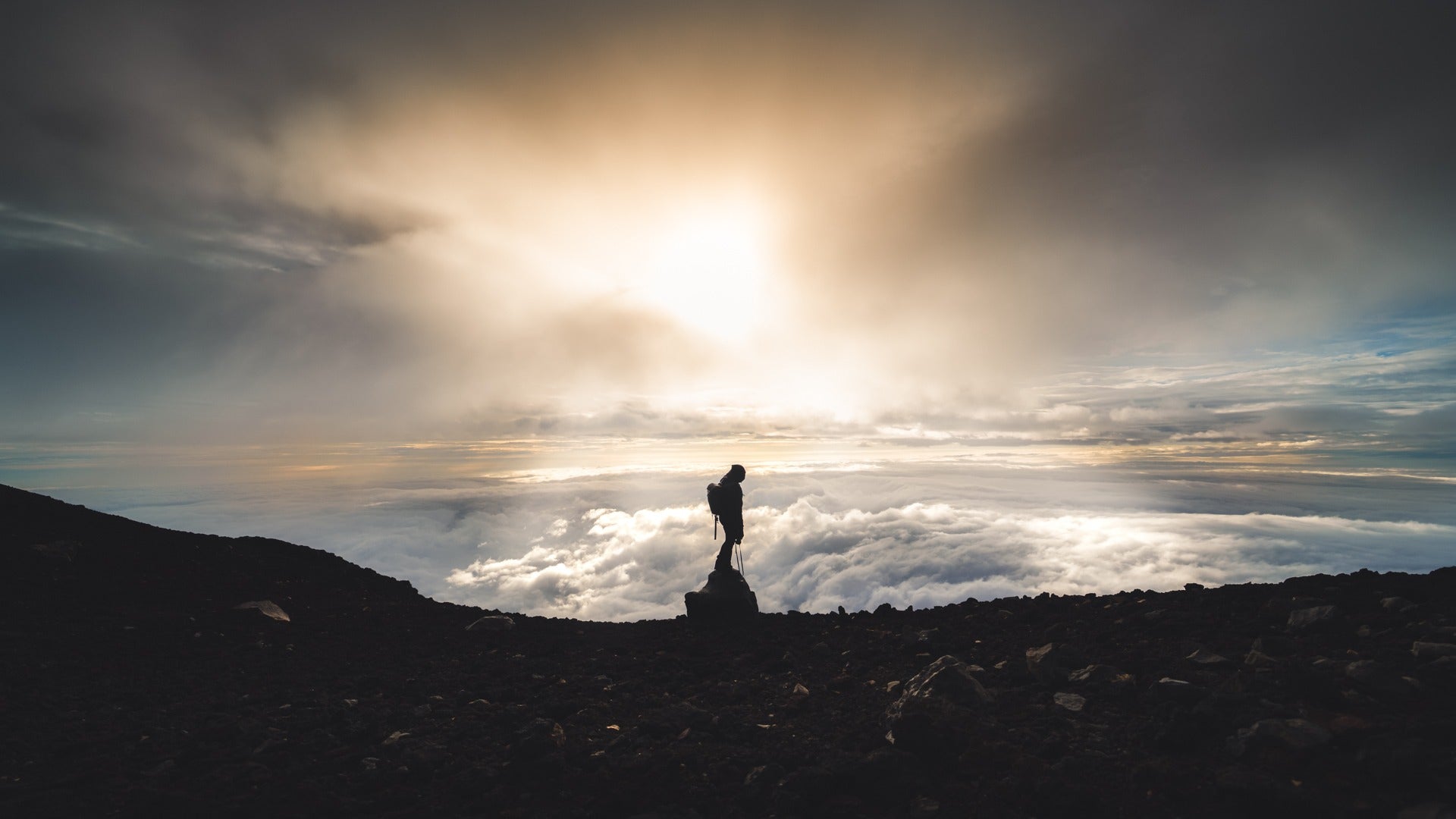They say that experience is the best teacher.
That you can learn all you want by consuming tomes of knowledge, but only by going through the action of doing the experience, do you truly, deeply understand. Let me tell you what I mean.
Fuji-san is Japan’s most iconic natural wonder. Standing a cool 3776 metres above every city in Japan, it’s huge. But the sheer dominance of it when looking from a distance is exponentially dwarfed by how intimidating it looks like from its base.
Despite its size, people having been pilgrimaging up it for centuries, and my good friend Hojae and I decided to go on our own pilgrimage up Japan’s tallest mountain too.
But there’s an old Japanese proverb about climbing Mt Fuji. It goes something like this:
He who climbs Mt Fuji once is a wise man; he who climbs twice is a fool
…and after having that experience, I really understand what they mean.
It’s not because it’s a technically ‘difficult’ climb. You’re not scaling up the side of cliff faces, using technical climbing gear, or shimmying uneven terrain. All of the routes are fairly rocky, with (mostly) worn gravel and volcanic rock paths to climb, some worse than others, but it’s not difficult.
But it sure as hell ain’t easy. It requires a pretty high level of physical fitness and endurance to reach the top, especially if you do it the way we did.
It’s totally worth it and you’ll be rewarded in kind for the persistence though.
The approach
There are 4 different trails (courses) of varying length and difficulty. Yoshida is the most popular, with an average length and easier climb. There’s also Subashiri and Gotemba courses. And then there’s the one we chose - the Fujinomiya course - the shortest and (little did we know) steepest option.

We weren’t experienced climbers by any stretch of the imagination, but we were physically strong and thought it would be a good fit for us.
And it would have been, if we had split the journey over two days and booked a sleep overnight in one of the several huts along the trail.
Part way up the mountain, there are sleeping huts you can stay in to catch some zzz’s and rest, before continuing the rest of the hike a few hours before sunrise in a rested state.
Almost everything we read about the Mt Fuji hike told us to do that.
The plan was to get there early, hike for a few hours, rest in a hut and sleep, then with a few hours till sunrise, wake up and hike the rest to summit it in time.
But of course, some things just don’t go to plan. 😅
Little did we know that what we would be doing what was called ‘Bullet climbing’ - Arriving, non-stop hiking to the top, watching sunrise, then climbing back down again.
This is highly not recommended - not just by me, but by every other Japanese tourism outlet too.
But hindsight is 20-20, and yeah… this is the story of how we did it anyway.
The beginning of hiking up Mt Fuji
All the courses start at the 5th station and finish at the 10th - the top. After sitting in our bus navigating through an Initial-D course in the fog, we eventually arrived at Fujinomiya-guchi - the new 5th station for this course.
It was cold, rainy, wet, and we were severely underprepared and underdressed for what was to come. After all, we had just come from the scorching oven that is the city of Kyoto in the summer, facing 35 degree heat in 95% humidity just a few hours before.
Dressed in shorts and shirt, we ran around the rainy 5th station trying to find out how to book one of those huts we could sleep in, and after observing how well prepared the other climbers were and speaking to some of the locals, not only did we find we were under-dressed, but we also found that you had to book way in advance to get a hut - and of course, it turned out that there were none available that day.
To make things worse, we were several hours too early to begin our hike (or so we thought), it was raining hard with a heavy fog, and a decent meal was miles away.
Disappointed and hungry, we sat at the 5th station for a few hours, waiting for the rain to die down, trying our best to prepare ourselves by purchasing overpriced provisions and rain gear.
It wasn’t the best start… but it wouldn’t be a real adventure without a bit of mis-adventure, right?

The ascent up Mt Fuji
Despite our position, we remained positive. And when the time was right, we made our move.
The start of the ascent really sets the tone of the entire hike straight away. On the Fujinomiya trail, although things start on a road and then up some concrete steps, the terrain quickly changes from the familiar man-made trail to the crunchy under-foot sound of small volcanic rock. Not only that, but the steepness of the climb is something that really (figuratively and literally) takes your breath away.
My first thought in these initial moments was “shit, it’s gonna be this steep the entire way up?!”. I mean, intellectually, I knew this was going to be the case - we were going to 3776m above sea level after all - but damn, reality really hits you hard sometimes.
Continuing in the absolute pitch black of the night, with no reference to how high we were actually climbing, nor a visual measure of how far we had to go - one step in front of the other, slowly but surely, we would make our ascent.
We had made it to the first station (called the 6th station) and rested for awhile. We were okay. Panting hard and wet from the rain, but luckily it had stopped by the time we got to the station.
Our brief pause showed us the enthusiasm of others also at the station and we felt good that we weren’t alone on this hike. In fact, there were hundreds of others doing it at the same time too. Everyone of varying age and physical fitness. Locals, tourists, climbers, humans. Even though everyone was on their own personal journey, there was a huge sense of collective as we all made it up the mountain together at our own pace.
Further up the trail, things started to get harder. The rocks became larger and more uneven, it became way more steep, and the temperature started to drop rapidly to near zero (c) and I didn’t know whether I was too hot from the climb, or too numb from the cold with my jacket off.
But one foot in front of the other. On and on. Hojae and I encouraging each other when we started to slow down. I was super glad I hadn’t done this alone.
Our pace was slow. We were actually getting passed by some locals who seemed twice our age, but for some reason had superhuman endurance or something, giving us a quick “Konnichiwa” and a smile as we let them pass us on the narrow paths.
Looking up, we could see the trail to the next station - the 7th - illuminated by the headlamps of other climbers off in the distance. Eventually, we made it there too.
The 7th station
We stayed for awhile. We needed to. Absolutely drenched with sweat and my knees starting to give out (it’s an old injury), we were tired, but still in high spirits.
The 7th station made us really appreciate how far we had come. We were above the cloud line at this point, with nothing but the moon to illuminate our surroundings. It was ethereal. It was magical. It was… half way.


We were also behind schedule. It was supposed to be a 5-7 hour hike up, but 4 hours in, we were only half way. The threat of not making it for the 4:30am sunrise was looming and we needed to hustle.
Moving on, we slowly made our way to the 8th.
…and then it happened. Not all at once, but it had become a big enough problem that it slowed us down substantially - I started getting affected by the altitude and started seeing stars.
Again, I’m not a sloth, but I’m not the fittest - I hit the gym a few times a week and can run an 8 minute mile. But the air was getting thin without me realising it and I was running out of breath so fast that every time I closed my eyes, all I could see were stars. I was dizzy and lightheaded. Not to mention my knee was giving out.
I was a burden.
Every 100 steps we took was followed by a minute rest. I had to stop.
But I didn’t want to give up. It was too late to turn back - there was only forward. There only ever is.
By the time we had reached the 8th station, we were already 6 hours in.
Exhausted, I collapsed on one of the seats, dehydrated and hungry, dizzy and fatigued. A Japanese woman saw the both of us suffering and kindly gave us some drinks she had brought for herself. Her kindness really lifted our spirits and reminded us to be positive and to stay encouraged to finish of the rest of this bullet climb.
After resting for what seemed like an hour and setting off again, we made it to the 9th.
At the 9th, we were faced with a choice. There was everything you could need at the huts up there - cooked food, canned oxygen, water. But with just 1 and a half hours to go till sunrise, we could either sit there, eat and replenish ourselves and potentially miss sunrise, or we could just rest a short time, keep going and potentially make it.
We chose the latter.
On we went. It felt like the right move. I started to feel better physically. The dizziness was still there, but fading slowly. The rest made my knee better, and we started putting on the pace.
Then, as we were 1 hour away from the peak, clouds started to roll in and it started to rain again. Throughout the journey, it was a never-ending cycle of rain, wind, cold, and calm, and the higher we got, the more torrential the weather became.
An hour out from sunrise, ambient light was starting to pick up. We started seeing the faces of other climbers, the terrain we were climbing on, and just how high 3460 meters looks like when you’re on a mountain side.
The rolling clouds blocked the view of the peak though, and again, we had no other visibility and no other choice than to put one foot in front of the other and just hope to make it in time for sunrise.
The peak of Mt Fuji
We missed it by just a few minutes.
We actually got blocked at the end by a long line of hikers waiting to get up onto the peak.
But it didn’t matter.
We were standing on the top of Japan’s tallest point, and in a sweaty, tired, almost looney state, we were elated and proud with how far we had come.
We joined the hundreds of other hikers at the peak. Watching them reach the top of their own trails, sympathising with their own efforts to get there.
Collectively, we enjoyed the sights of our reward and revelled in the terrain.
Hojae and I explored the peak, we took photos, and really took the time to enjoy the experience.








The descent
Of course, there’s no fast way to get off the mountain than to go back down the way you came.
What’s supposed to take 3-5 hours, took us bang on about 5 hours. If you take the Fujinomiya trail, it’s not only steep, but all the small rocks make it extremely slippery to navigate.
On the way down, our roles reversed. Hojae’s boots kept giving him grief, and he slipped and fell a few times. We took it easy. After all, it was daylight and we could actually see the terrain we had climbed up the night before. Seeing the difference was insane, with constant comments from us saying “Shit, we climbed this last night?!”. The realisation was amazing.
The terrain was beautiful too.



At the bottom, relief and fatigue kicked in as we then made our way to Tokyo to continue the rest of our Japan trip.
We reflected on the experience we had. The past 16 hours was a journey, a test of will and grit; a pilgrimage. The bullet climb.
The hike is an experience I’d recommend to everyone to do at least once in their lives - although definitely split it up into two days.
Mt Fuji is so beautiful from every angle and the hike up is both a test of your will and a spiritual experience.
It’s perhaps an experience left done once, though. I try to avoid being a fool when I can.
-
Header image by @hotherside - Edited by @pat_kay





0 comments